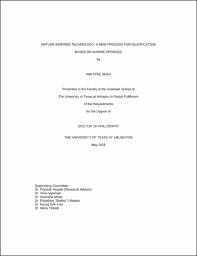
ATTENTION: The works hosted here are being migrated to a new repository that will consolidate resources, improve discoverability, and better show UTA's research impact on the global community. We will update authors as the migration progresses. Please see MavMatrix for more information.
Show simple item record
| dc.contributor.advisor | Aswath, Pranesh B. | |
| dc.contributor.advisor | Varanasi, Venu | |
| dc.contributor.advisor | Motta, Antonella | |
| dc.contributor.advisor | Meletis, Efstathios | |
| dc.creator | Shah, Ami Atul | |
| dc.date.accessioned | 2020-06-23T21:56:18Z | |
| dc.date.available | 2020-06-23T21:56:18Z | |
| dc.date.created | 2018-05 | |
| dc.date.issued | 2018-05-23 | |
| dc.date.submitted | May 2018 | |
| dc.identifier.uri | http://hdl.handle.net/10106/29168 | |
| dc.description.abstract | Silica is used in various industries, ranging from automobile industry for tires to semiconductor industry, paints and coatings, biomedical devices & applications to food & drug industry. The current processing techniques for precipitated silica involve harsh conditions like high temperature and extreme pH conditions. Nature already has highly evolved production techniques for silica. They run at physiological conditions and exhibit intricate control over the synthesis, leading to very pure and ornate siliceous structures. These structures exhibit organized architecture at scales as small as nano-dimensions.
The proposed research work is a step, towards development of new techniques that bio-mimic the silica production where they can be scaled up for industrial productions. Also the products obtained can be easily integrated into its potential applications, specifically bone tissue engineering has been targeted in this study. For this the investigators have first gone through an extensive and defined literature study. On basis of this they select the best material alternatives to mimic the biosilica silicification process. These techniques replace the need to use raw materials harvested from the natural marine species and thus avoid disturbing the marine ecology. They optimize the parameters to achieve steady state nucleation, growth and precipitation. These precipitates are extensively analysed for understanding mechanism of the process and the effect of the parameters on the final precipitate. Techniques like SEM, EDX, IR spectroscopy methods, crystalline-amorphous phase studies with XRD, and chemical environment at molecular level via XANES are employed. Applicability of the product in biomedical applications is tested by exploring its potential as composite material in scaffolds for bone tissue engineering. The basic biocompatibility of the material is tested using them as composites with fibroin and making 2D test structures viz. films. The material and biological properties of these created particles are compared with natural spicules obtained from Tethya aurantia, which were primarily characterized to gather the knowledge of the material that is bio-mimicked.
This study is pursued with view that successful generation of silica particles will contribute to greener, smarter and faster technique of production of silica and other alkoxides that have similar precipitation techniques currently being employed. It will also present us with a potential replacement biomaterial for bone tissue engineering. | |
| dc.format.mimetype | application/pdf | |
| dc.language.iso | en_US | |
| dc.subject | Biosilica | |
| dc.subject | Marine sponges | |
| dc.subject | Amorphous SiON | |
| dc.subject | TEOS green synthesis | |
| dc.subject | Bone Tissue engineering | |
| dc.subject | | |
| dc.title | Nature Inspired Technology: A New Process For Silicification based on Marine Sponges | |
| dc.type | Thesis | |
| dc.degree.department | Materials Science and Engineering | |
| dc.degree.name | Doctor of Philosophy in Materials Science and Engineering | |
| dc.date.updated | 2020-06-23T21:56:19Z | |
| thesis.degree.department | Materials Science and Engineering | |
| thesis.degree.grantor | The University of Texas at Arlington | |
| thesis.degree.level | Doctoral | |
| thesis.degree.name | Doctor of Philosophy in Materials Science and Engineering | |
| dc.type.material | text | |
Files in this item
- Name:
- SHAH-DISSERTATION-2018.pdf
- Size:
- 7.499Mb
- Format:
- PDF
This item appears in the following Collection(s)
Show simple item record


